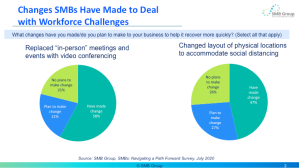Businesses of all sizes have been confronted by daunting challenges due to the COVID-19 pandemic, but small and medium businesses (SMBs) have arguably borne the brunt of the damage.
In SMB Group’s July 2020 survey, SMBs: Navigating a Path Forward, co-sponsored by Sage Intacct, an overwhelming 78% of SMB respondents said that COVID-19 was negatively impacting their business. That’s in stark contrast to our 2019 SMB Digital Transformation Study, in which 64% of SMBs said they were forecasting increased revenue growth.
 The pandemic is testing SMB resilience across all functional areas, including of course, human resources and talent management. Many are dealing with extreme staffing volatility: 59% of SMBs have taken one or more actions to trim payroll, and 58% are now planning to bring workers back, hire new workers, increase hours, or increase employee pay. SMBs are facing similar turbulence in contractor/1099 staffing as well.
The pandemic is testing SMB resilience across all functional areas, including of course, human resources and talent management. Many are dealing with extreme staffing volatility: 59% of SMBs have taken one or more actions to trim payroll, and 58% are now planning to bring workers back, hire new workers, increase hours, or increase employee pay. SMBs are facing similar turbulence in contractor/1099 staffing as well.
Amidst this unpredictability, businesses cite operating under new social distancing and safety requirements, supporting employees in new, virtual work conditions, and improving employee productivity among their top business challenges.
SMBs must plan for today and tomorrow
 If you’re like most SMB decision-makers, you’re already making or planning to make changes to handle these unprecedented human resource and workforce management challenges. In our study, 62% of respondents said they were changing the layouts of physical locations, such as offices, factories, and stores.
If you’re like most SMB decision-makers, you’re already making or planning to make changes to handle these unprecedented human resource and workforce management challenges. In our study, 62% of respondents said they were changing the layouts of physical locations, such as offices, factories, and stores.
 In addition, two-thirds had instituted or expanded work-from-home (WFM) programs, and slightly 57% of these companies plan to increase spending to better equip remote workers.
In addition, two-thirds had instituted or expanded work-from-home (WFM) programs, and slightly 57% of these companies plan to increase spending to better equip remote workers.
But to both survive through continuing uncertainty, and to come out stronger on the other side, businesses need to think beyond these types of immediate challenges. With the economy in flux, the entire concept of the workplace changing, and employees’ work style needs and preferences shifting, your business needs to be ready to proactively adjust and adapt.
The pandemic also exacerbates problems SMBs have always faced in the human resources domain. Before COVID-19, SMBs were already at a disadvantage when competing for talent against larger firms that typically provide better salaries, benefits, and opportunities for career advancement. SMBs also often lack the expertise and solutions needed to build strong recruitment and retention programs.
At this critical juncture, SMB decision-makers can continue to react and let external forces control the situation. Or they can decide to be proactive and put the expertise and solutions in place that can provide the business with the agility and insights necessary to adapt workplace and workforce strategies to prosper.
Planning a new way to work for your business
While all businesses must adapt to this dynamic environment, no two businesses are the same. Yet, some strategic considerations are universal.
For instance:
- The tectonic shift to remote work has caused many businesses and employees to question whether they will ever go back to a traditional office or work site environment. Of course, businesses that do need or want to send all employees back must ensure that employees have a safe physical environment to return to. But many businesses will shift to a hybrid or even all-remote work environment. Consider which jobs can be done offsite and which ones can’t, both now and in the future. Think about how to better enable remote work and collaboration and physical requirements to facilitate new, more flexible work styles—from more meeting space and less individual space in company offices, to providing remote workers with stipends or equipment to create productive WFM offices.
- Businesses that decide to continue with a more flexible, hybrid workplace approach also need to assess how this impacts employee experience. For example, if you have employees working in different time zones, it may make sense to designate a specific block of hours for real-time, collaborative work—such as virtual meetings—and then allow employees to decide when to get the rest of the work done. Consider the implications for everything from onboarding to career advancement to exit interviews and create policies that help improve employee engagement and retention.
- As conditions change, companies need to identify the skills employees need to meet new requirements. Retailers, for instance, may need a lot less people in physical stores and a lot more with skills to build and manage ecommerce storefronts and provide service via chat and phone. Categorizing and inventorying jobs and skills, identify gaps, reskilling existing employees for new roles, and recruiting additional talent will be key to business sustainability.
Enabling data-driven execution with cloud-based HR solutions
 As evidenced in our study, cloud computing has been a lifesaver for SMBs during the pandemic. It has enabled them to keep operations going, adapt to new workplace requirements and remote working programs, and keep up with changing customer requirements. Across all application categories, 83% or more of respondents said cloud-based business applications have been valuable in sustaining their businesses—and 37% noted that the pandemic has made them more likely to choose a cloud solution for new application investments.
As evidenced in our study, cloud computing has been a lifesaver for SMBs during the pandemic. It has enabled them to keep operations going, adapt to new workplace requirements and remote working programs, and keep up with changing customer requirements. Across all application categories, 83% or more of respondents said cloud-based business applications have been valuable in sustaining their businesses—and 37% noted that the pandemic has made them more likely to choose a cloud solution for new application investments.
Clearly, the cloud has been essential in helping people to get their jobs done from home and collaborating with colleagues. But the value of cloud-based technology extends beyond this. In companies using cloud-based business applications, employees could immediately access cloud-based business applications—from HR to finance to CRM—from home when lockdowns suddenly went into effect. People could update and share data and workflows in real-time, giving everyone a consistent, accurate, and up-to-date view of the business—from purchasing to payroll.
Before the pandemic, integrated, cloud-based solutions were already relieving HR from mundane tasks so they could take on more proactive, advisory roles. With less administrative duties, HR can focus on helping management make better decisions about personnel and processes, enabling them to build more resiliency and flexibility in the workforce to cope with the shifting landscape.
The real-time, data-driven cloud-based business solutions also make more holistic, cross-organizational collaboration and insights possible. For instance, companies using integrated financial and human resources solutions, such as Sage People and Sage Intacct, can more readily identify trends, risks, and opportunities that can provide insights and new approaches to adapt as the “next normal” evolves.
Perspective
Investing in new technology solutions in a downturn may seem counter-intuitive during a downturn. But having access to the information you need to make the best HR and talent decisions can help ensure that your business has the people, policies, and programs in place for a successful future.
Employees are the greatest asset a company can have. Having data to guide your decisions will ensure that you can better align your workforce and employee experience with business goals and market realties now, and as the pandemic subsides and the business climate improves—and do so more expeditiously than those that don’t.
© SMB Group, 2020
Source: Laurie McCabe’s Blog

